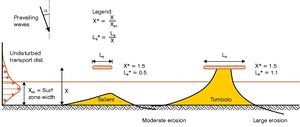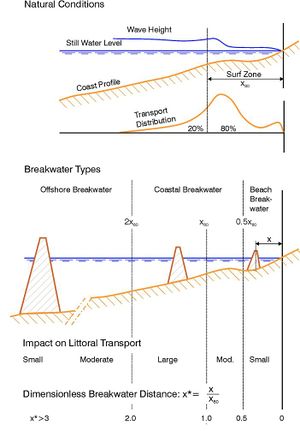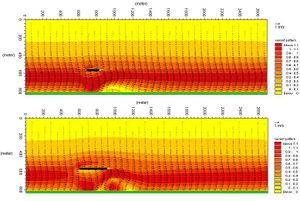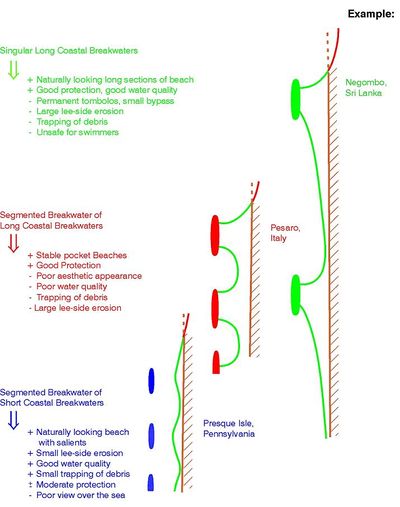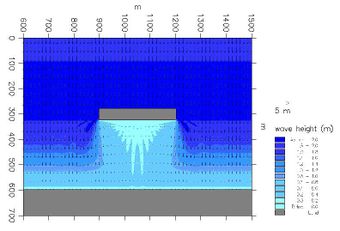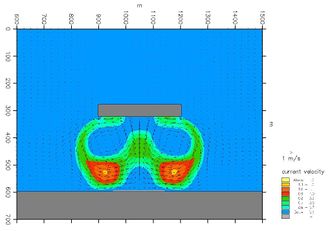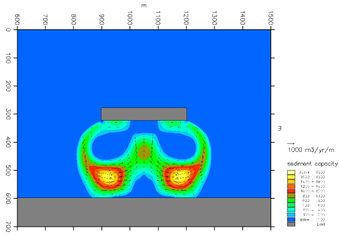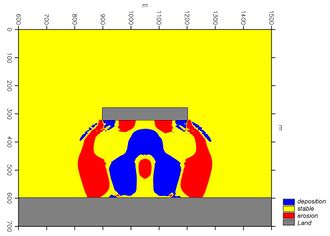Detached breakwaters
Definition of Detached breakwater:
A structure parallel, or close to parallel, to the coast, built inside or outside the surf-zone. Detached breakwaters are mainly built with two purposes, either to protect a ship wharf from wave action or as a coast/shore protection measure.
This is the common definition for Detached breakwater, other definitions can be discussed in the article
|
Detached breakwaters are used as shore and coast protection measures. In general terms, a detached breakwater is a coast-parallel structure located inside or close to the surf-zone.
Contents
- 1 Variable of breakwater schemes
- 2 Purpose of a breakwater
- 3 Defining a detached breakwater
- 4 Functional characteristic of emerged detached single breakwaters
- 5 Influence on flow patterns
- 6 Functional characteristics of emerged detached segmented breakwaters
- 7 Hydrodynamic impacts
- 8 Morphological impact
- 9 Other impacts
- 10 Temp
- 11 References
Variable of breakwater schemes
Breakwater schemes have many variables, which determine the impact on the shoreline. The variable parameters are outlined in the following:
- Emerged, submerged or floating
- Distance from shoreline and location relative to the surf-zone
- Length and orientation
- Single or segmented
- Special shapes
A complete description of combinations of all these parameters falls outside the scope of this section but there are further descriptions in Shore protection.
Purpose of a breakwater
A shoreline management breakwater serves two purposes:
- To provide shelter from the waves
- Through this shelter, to manipulate the littoral transport conditions and thereby to trap some sand
Some breakwaters, offshore breakwaters, are constructed in deep water as a special type of port, providing shelter for a piled berth connected to the coast by a piled jetty. This kind of port is normally used when the slope of the coastal profile is very gentle, which makes the construction of a traditional port very costly. The philosophy is that the distance to the shoreline behind this kind of port will minimise the impact on the shoreline. However, in practice, it is very difficult to construct such a zero impact port.
Defining a detached breakwater
A detached breakwater can be characterised by several parameters as shown in the figure below.
- Definition of parameters characterising detached breakwaters and accumulation forms.
The most important parameters are:
- LB Length of the breakwater
- x Breakwater distance to shoreline
- x80 Surf-zone width, approximately 80 % of the littoral transport takes place landwards of this line
Dimensionless length and distance:
- LB* = LB/x Breakwater length relative to breakwater distance to shoreline
- x* = x/x80 Breakwater distance relative to surf-zone width
Accumulation forms:
- Salient: When the dimensionless breakwater length LB* is less than approx. 0.6 to 0.7, a bell-shaped salient in the shoreline will form in the lee of the breakwater. However, parameters other than the breakwater length and distance also influence the accumulation pattern.
- Tombolo: When the dimensionless breakwater length LB* is greater than approx. 0.9 to 1.0, the sand accumulation behind the breakwater will connect the beach to the breakwater in a tombolo formation. But again, parameters other than the breakwater length and distance influence the accumulation pattern
If there are several breakwaters in a series, this is referred to as a segmented breakwater, where the length of the gap between the breakwaters is denoted:
- LG Length of gap between breakwaters in a segmented breakwater
Functional characteristic of emerged detached single breakwaters
A detached breakwater provides shelter from the waves, whereby the littoral transport behind the breakwater is decreased and the transport pattern adjacent to the breakwater is modified. These characteristics of a breakwater are utilised in different ways for various types of breakwaters by varying relevant parameters. There are three different types of breakwaters, as can be seen in figure below.
- Types of detached breakwaters.
A detailed description of the following three types of detached breakwaters can be found here.
- Offshore breakwaters
- Coastal breakwaters
- Beach breakwaters
Offshore, coastal and beach breakwaters - description
Influence on flow patterns
The influence of various coastal breakwaters on the flow pattern of the longshore current is discussed in the following. Two breakwaters, one relatively long and the other one relatively short, are considered. Immediately after the construction of the breakwaters, the flow pattern is simulated by applying DHI’s numerical model system MIKE 21. Two modules have been applied, the parabolic mild slope wave module and the depth-integrated hydrodynamic module, MIKE 21 PMS and HD, respectively. The dimensions of the breakwaters are:
LB x x80 LB* x* The long breakwater 312 m 240 m 250 m 1.3 0.96 The short breakwater 144 m 240 m 250 m 0.6 0.96
The bathymetry was a plane beach with constant slope of 1:50 Irregular and directional waves with: Hs = 2.8 m, Ts = 8.0 s and α0 = 12o were used.
The flow patterns for these two breakwaters are presented in the figure below.
- Flow pattern for a “short” and a “long” breakwater, LB* =0.6 and LB* =1.3, respectively.
Long breakwater
The long breakwater causes major changes in the flow pattern. There are increasing current speeds towards the lee zone, high current speeds close to the breakwater heads and circulation in the downstream end of the lee zone. This current pattern and the corresponding sediment transport pattern cause the formation of a tombolo (Fig 12.13 - Definition of parametrs...). There will also be local scour close to the breakwater heads. The eddy in the lee zone will remain, even after the tombolo has formed, and the current around the upstream head of the breakwater will increase with a higher offshore component. The current eddy and the scour holes will be dangerous for swimmers, and the jet directed offshore will cause a loss of sand and decreased bypass, resulting in relatively large lee side erosion. The local lee bay will tend to collect seaweed and debris. Furthermore, the tombolo provides easy access to the breakwater, which is not practical, as walking on the structure and jumping from it can be dangerous.
Short breakwater
If the breakwater is fairly short, the flow pattern will be quite different, as seen in the above figure. There will be no high currents at the breakwater heads; there will be only a minor tendency for eddy formation and there will be only slight changes in the general pattern of the longshore current. The morphological response to such a breakwater will be a smooth salient in the shoreline; a tombolo will not form and there will be no scour holes at the end of the breakwater heads. There will be no offshore loss of material, and the lee side erosion will be mild. These are all positive effects; the negative effect is that the protection, provided by a short breakwater, is limited. It will secure a wider beach locally, but it will not be able to stabilise a long section of shoreline by a stable sand filet. If the sand filet consists of nourished sand, frequent re-nourishment will be necessary.
Optimality
The optimal solution is probably somewhere between a long and a short breakwater. It must form a solid salient, but not a tombolo. This solution is balanced between the requirements for coast and shore protection, the minimisation of downstream impacts and seaweed trapping, and the optimisation of safety. Other modifications to the breakwater can also be considered. This will be discussed under the heading: Modified breakwaters and headlands.
Functional characteristics of emerged detached segmented breakwaters
The above discussion was related to single breakwaters, but shoreline management schemes often utilise segmented breakwaters. A segmented breakwater scheme provides many possibilities, ranging from total coastal protection to mild shore protection. The figure below shows the characteristic shoreline development, which can be obtained with segmented breakwaters with various combinations of breakwater lengths and gap widths.
- Characteristics for various segmented breakwater schemes.
A mixture of seawalls, revetments, groynes and breakwaters has, in the past, often been used in densely populated areas as coastal protection against long-term erosion. In some places the protection was co-ordinated, but most often it was everybody’s individual fight against the sea. Such areas are characterised by lost beaches, poor passage along the coastline and poor aesthetic appearance. The natural beauty of the coastal landscape is lost due to coastal protection measures and erosion continues. Such areas require an urgent upgrade to secure the values behind the coastline, as required by the landowners, and to re-establish the shore to the highest possible level, as required by the public and the authorities. This calls for a well co-ordinated shoreline management scheme. With modern techniques and sufficient funds, it will be possible to upgrade the spoiled coastline to a nearly natural condition. However, it is almost impossible to re-establish the active coastal cliff, which is also a valuable coastal resource. The only way to achieve this is to allow the natural coastal erosion to continue. However, this requires that the authorities purchase the coastal land and allow it to develop naturally. In most cases this is unrealistic, but one solution may be to leave public-owned sections without protection, provided they are of a suitable length.
In such heavily populated and mostly privately owned areas, it will normally not be practical to choose a solution using nourishment alone, as it will not provide sufficient safety against coastal erosion, and as it is also difficult to manage. In this case a segmented breakwater scheme is a good choice, and it can be tailored to suit the requirements agreed upon by the interested parties. A pure nourishment solution requires substantial public involvement.
The numerous possibilities are illustrated by the three very different schemes sketched in the figure above about Characteristics for segmented breakwater schemes. It is evident that nearly all combinations of requirements can be met. The most difficult aspect of such projects is often the public and political process, which has to be carried through to reach consensus. The importance of this process must not be underestimated in the planning process.
Hydrodynamic impacts
A detached breakwater has the following impact on the hydrodynamic conditions in the adjacent area:
- The breakwater shelters partly from the waves; however, as the waves diffract into the sheltered area, a complete shelter cannot be obtained. The longer the breakwater, the better the shelter. Submerged and floating breakwaters provide less shelter.
- Wave-overtopping of submerged or low breakwaters will cause an additional supply of water in the area behind the breakwater, and consequently some compensation currents running out the sheltered area.
- The wave set-up on the foreshore is less in the sheltered area than outside, which generates local currents towards the sheltered area along the foreshore from both sides of the breakwater so that two eddies develop. These eddies also develop in the case of oblique wave approach.
- The longshore current is partially blocked by the circulation currents; this causes some of the longshore currents to be diverted outside the breakwater.
- Wave and current conditions at a detached breakwater with a perpendicular wave approach.
Morphological impact
And the following impact on the morphological conditions:
- The littoral transport in lee of the breakwater decreases due to the attenuated wave and longshore currents in the area sheltered by the breakwater. This causes the trapping of sand behind the breakwater depending on the conditions. As a rule-of- thumb, the trapping of sand will develop into a tombolo formation connecting the breakwater and the shore by sand deposits, if the length of the breakwater is equal to or longer than 0.8 times the distance between the shore and the breakwater. For shorter breakwaters, only a salient in the shoreline will develop.
- The diversion of the longshore currents will cause the development of local erosion close to the heads of the breakwater.
- The trapping of sand, especially if a tombolo has developed, will cause lee side erosion downstream of the breakwater. This downstream erosion is very similar to what is developed for groynes. However, there are more parameters involved in breakwaters, so it is possible to manipulate the transport in a more refined manner.
- A breakwater traps sand under all circumstances, even if the net transport is zero. This means also that there will be a coastal impact in any case.
- Initial sediment transport pattern and initial morphological impact caused by a detached breakwater for perpendicular wave approach.
When several breakwaters are constructed in a row, the system is referred to as a segmented breakwater. A segmented breakwater is used to protect long sections of shoreline; the downstream coastal impact will be correspondingly larger than for a single breakwater.
Other impacts
Other impacts by breakwaters:
- If segmented breakwaters are constructed with too small gaps, the water exchange in the embayments between the breakwaters may be poor.
- Breakwaters normally obstruct part of the view over the sea, which means that the visual impact can be unacceptable.
- Swimmers may feel tempted to use the sheltered area in connection with detached breakwaters, but the circulation currents can be dangerous.
Applicability of detached breakwaters
Temp
References
Author: Karsten Mangor, DHI, 2004. km@dhi.dk. All content is written by Karsten Mangor unless referenced otherwise.
